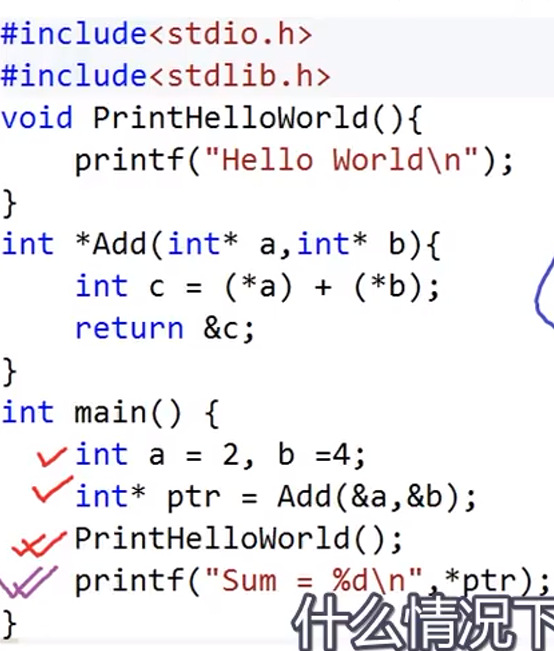笔记来源
【强烈推荐】4小时彻底掌握C指针 - 顶尖程序员图文讲解 - UP主翻译校对 (已完结)_哔哩哔哩_bilibili
Introduction to pointers in C
-
计算机在定义一个变量时,在Memory (RAM) 中划出一片地址空间来存储,并在一个查找表中添加一条记录,如
int a;存储为(a int 0x204),通过地址来访问变量,其中int占4个字节;char占1个字节;float占4个字节;指针的长度取决于操作系统位数,如64位操作系统,指针长度是8 -
指针是一个变量,存放着另外一个变量的地址,值得注意的是指针是一个变量!!
p是一个整数型的指针(指向整数),通过改变p的值,我们可以通过p访问到不同的变量

-
指针的定义
1
2
3
4
5
6
7
8
9
10int a; // 定义了一个整数变量,分配了0x204的地址
int *p; // 定义了一个整数型的指针,分配了0x64的地址
p = &a; // 将p的值赋为0x208,指向了a
print p // 204
print &a // 204
print &p // 64
print *p // 4
// *p:解引用(dereferencing),与&操作相反
*p = 5 // a的值变成了5p -> address
*p -> value at address
Working with pointers
-
Null指针,空指针的出现可能导致程序崩溃
1
2
3
4
5
6
7
int main()
{
int a;
int *p;
printf("%d\n", p);
} -
赋值
1
2
3
4
5
6
7
8
9
int main()
{
int a = 10; int b = 5;
int *p;
p = &a;
printf("%d\n", p);
*p = b; // 不会改变p的值,p仍然指向a
} -
Pointer arithmetic
1
2
3
4
5
6
7
8
9
10
11
int main()
{
int a = 10;
int *p;
p = &a;
printf("%d\n", p); // 0x204
printf("%d\n", p+1); // 0x208
// p是一个指向整型类型的指针,对其+1操作会得到下一个整型数据的地址
printf("%d\n", *(p+1)); // 指针越界,得到的是随机值
}
Pointer types, void pointer, pointer arithmetic
-
指针是强类型的,需要用特定类型的指针变量来存放特定类型变量的地址,那么既然指针仅仅存放着一个地址,为什么要分不同类型呢?答案是指针需要dereference,不同数据有不同的大小
-
如果打印p的值,应该是200,即首地址,取a的值时,计算机根据数据类型选择要取的地址范围

-
代码实例:
1
2
3
4
5
6
7
8
9
10
11
12
13
14
15
16
17
18
19
20
21
22
23
24
int main()
{
int a = 1025;
int *p;
p = &a;
printf("size of integer is %d bytes\n", sizeof(int));
printf("Address = %d, value = %d\n", p, *p);
printf("Address = %d, value = %d\n", p+1, *(p+1));
char *p0;
p0 = (char*)p; // 做一次typecasting
printf("size of char is %d bytes\n", sizeof(char));
printf("Address = %d, value = %d\n", p0, *p0);
printf("Address = %d, value = %d\n", p0+1, *(p0+1));
}
Output:
size of integer is 4 bytes
Address = 6422028, value = 1025
Address = 6422032, value = 7372304
size of char is 1 bytes
Address = 6422028, value = 1
Address = 6422029, value = 4
// 1025 = 00000000 00000000 00000100 00000001 -
通用指针
1
2
3void* p0;
p0 = p;
printf("Address = %d, value = %d\n", p0, *p0); // 只能打印地址,不能dereference
Pointer to pointer

1 |
|
Pointers as function arguments / Call by reference
-
指针的一个用处是用于函数传值,下面的传值只传了值,没有传参数(形参&实参)
1
2
3
4void increase(int a)
{
a = a + 1;
}
一个程序的内存空间分为以上四个部分,Code是程序的指令语句,Static/Global是分配给程序的静态/全局变量,Stack是分配给函数调用的局部变量和参数等,Heap是动态分配内存的区域;在函数调用栈中,函数只能访问自己栈帧中的局部变量
1
2
3
4
5
6// 正确的如下
void increase(int* p)
{
*p = *p + 1;
}
increase(&a);
Pointers and Arrays
-
数字首元素的地址称为数组的基地址
1
2
3
4
5
6int A[5];
int* p;
p = A;
Address -> &A[i] or A+i
Value -> A[i] or *(A+i) -
A和&A[0]的值相同,都是数组基地址,可以理解成数组就是指针
Arrays as function arguments
-
编译器在编译时,只复制了数组的基地址到一个定义的同名指针中,而不是传递整个数组的空间,隐式地将
sum()函数的参数int A[]变成了int* A,这节省了调用的函数栈帧的空间大小,是编译器做的优化(传引用,而不是传值)
1
2
3
4
5
6
7
8
9
10
11
12
13
14
15
16
17
18
19// 传了同一数组,为什么长度算出来不一样?
// 因为一个是数组,一个是指针
int sum(int A[]) // or int* A
{
printf("sum :%d %d\n", sizeof(A), sizeof(A[0]));
}
int main()
{
int A[] = {1,2,3,4,5};
int size = sizeof(A)/sizeof(A[0]);
sum(A);
printf("main :%d %d\n", sizeof(A), sizeof(A[0]));
}
Outputs:
sum :8 4
main :20 4
Character arrays and pointers
-
字符串就是字符数组,以
'\0'作为结尾1
2
3
4
5
6
7
8
9
10
11
12
13
int main()
{
char A[3];
A[0] = 'L';
A[1] = 'e';
A[2] = 'o';
// A[3] = '\0';
printf("%s", A);
}
Leo饈r,取消注释的结果是Leo,没有多余的乱码字符数组实际上也是一个指针,不能直接对指针赋值
1
2
3
4
5// 定义字符数组时,可以
char A[20] = "Leo";
// 但是不可以
char A[20];
A = "Leo"; -
一个示例理解数组和指针的区别,这里
print()函数的参数C可以自增,因为在编译器看来,它就是一个指针
-
char C[20] = "Hello"; // string gets stored in the space for array char* C = "Hello"; // string gets stored as compile time constant,即应用程序代码区 C[0] = 'A'; // 常量不能被修改,程序会崩溃1
2
3
4
5
6
7
8
9
10
11
12
13
14
15
16
17
18
## Pointers and multi-dimensional arrays
## Pointers and dynamic memory
- 分配给栈的内存空间在程序运行期间不会增加,当产生过多的函数调用,如:无穷的递归等,可能会发生栈溢出的情况(stack overflow),而程序的堆的大小不是固定的,堆就是空闲的内存池,C语言中使用malloc、calloc、realloc和free四个函数使用堆,C++添加了new和delete两个函数
- malloc():malloc的参数是要在堆中申请的内存空间的大小,返回一个void pointer,通过cast可以变成指定数据类型的指针;使用堆上内存的唯一方式就是**reference**
```c
int* p;
p = (int*)malloc(sizeof(int)); // 这样就在堆中有了一块内存,可以存放一个整型
*p = 10;
free(p);
p = (int*)malloc(sizeof(int));
*p = 20; // 原来的内存在函数调用结束后不会被释放(像栈那样),造成了“内存泄漏”!要使用free()释放内存
malloc、calloc、realloc、free
-
malloc:对malloc返回指针先进行类型转换,之后可以使用
*(p+1)或者p[1]来写入堆使用malloc之后最好用
memset( p , 0x00 , sizeof(p) )初始化一下,养成良好的习惯 -
calloc:
malloc(3*sizeof(int))写成calloc(3, sizeof(int)),calloc函数会进行初始化,而malloc不会 -
realloc:已经申请了一块动态内存,希望改变大小,使用realloc函数,函数原型为
void* realloc(void* Ptr, size_t size)
Memory leak
- 以赌博游戏为例,如果在play函数中
char c[3] = {'J', 'Q', 'K'};这样定义数组,数组存储在函数栈帧中,每一次调用play函数后,都会清空栈帧,所以在程序运行过程中,占用的内存不会明显增长 - 如果
char *c = (char*)malloc(3*sizeof(char));这样定义数组,每一次调用play函数,都在堆中申请了一块内存,函数栈帧中只有一个指向这块内存的指针,如果不调用free函数释放,在程序运行过程中,占用的内存会不断增长,Java等语言已经有内存回收机制,而C/C++程序员要格外小心
Pointers as function returns
-
从栈顶向下传递局部变量或局部变量的地址(指针)是不被允许的,因为栈顶的空间先被释放,可能会被其他函数覆盖,而从栈底向上传递局部变量或局部变量的地址(指针)是可以的

sum函数结果会出错,被PrintHelloWorld函数覆盖
-
函数调用可以返回指针的情况:在堆上有内存地址(释放内存)或全局变量区上有变量时,如:

Function Pointers
-
一个函数就是一组存储在连续内存块中的指令,函数的地址称为函数的入口点,是函数第一条指令的地址,函数调用是一条跳转指令跳转到函数的入口点
1
2
3
4
5
6
7
8
9
10
11
12
13
14
15
int Add(int a, int b)
{
return a+b;
}
int main()
{
int c;
int (*p)(int, int); // (*p)不加括号就变成了返回指针的函数的声明
p = &Add; // 也可以写成 p = Add; 就像数组一样
c = (*p)(2, 3); // 解引用得到函数,并传参执行,也可以直接写成 c = p(2, 3);
printf("%d", c);
}
Function pointers and Callbacks
-
函数指针可以作为函数的参数,接受这个函数指针参数的函数可以回调指针指向的函数
-
代码示例:
1
2
3
4
5
6
7
8
9
10
11
12
13
14
15
16
17
18
19
20
void A()
{
printf("hello!");
}
void B(void (*ptr)())
{
ptr(); // call-back function that "ptr" points to
}
void main()
{
void (*p)();
p = A;
B(p);
B(A); // 也是可以的,因为函数名就是指针
} -
在数组排序中,升序和降序的代码十分相近,为了减少冗余代码,提出了传入比较函数的做法,qsort 是C语言中的一个标准库函数,用于对数组进行快速排序。它位于
<stdlib.h>头文件中,其函数原型如下1
2
3void qsort(void* base, size_t num, size_t size,
int (*compar)(const void*, const void*));
// base 是待排序数组的起始地址,num 是数组中元素的个数,size 是每个元素的大小(以字节为单位),compar 是比较函数指针比较函数(compar)是用户自定义的函数,必须满足以下规则:
- 如果第一个参数小于第二个参数,则返回负值
- 如果第一个参数等于第二个参数,则返回0
- 如果第一个参数大于第二个参数,则返回正值
比较函数的使用就是一个回调函数
1
2
3
4
5
6
7
8
9
10
11
12
13
14
15
16
17
18
19
20
int compare(const void* a, const void* b)
{
int A = *((int*)a);
int B = *((int*)b);
return A-B; // 改成 B-A 就成了降序
}
void main()
{
int i;
int A[] = {-31, 22, -1, 50, -6, 4};
qsort(A, 6, sizeof(int), compare);
for(int i=0; i<6; i++) printf("%d ", A[i]);
}
Outputs:
-31 -6 -1 4 22 50
本着互联网开源的性质,欢迎分享这篇文章,以帮助到更多的人,谢谢!